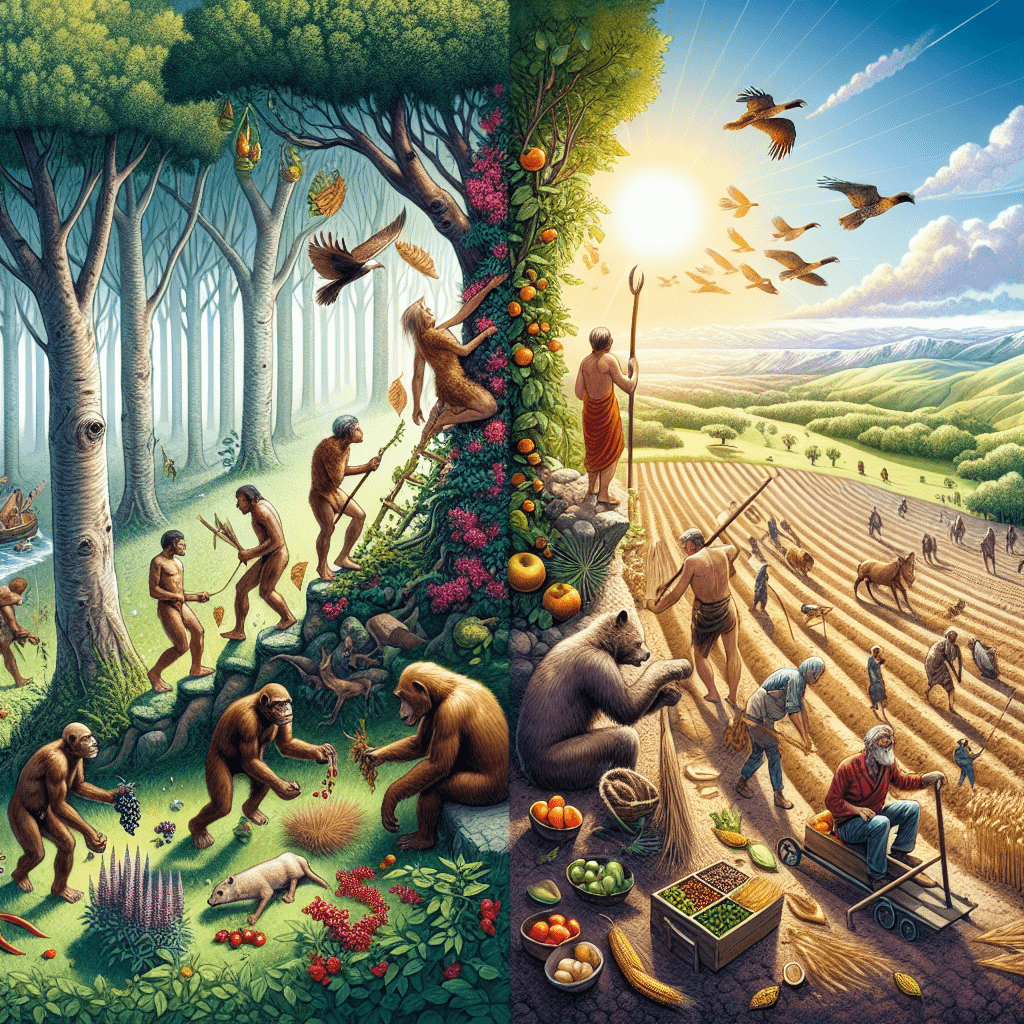[ad_1]
### From Foraging to Farming: The Evolution of Human Diets
The history of human diets is as old as humanity itself, reflecting a continuous and complex journey from the wild landscapes of our forager ancestors to the cultivated fields of the agricultural revolution. This journey encapsulates not just a change in what we eat, but also how we perceive, interact with, and manipulate our environment to suit our dietary needs.
#### The Foraging Era
For millions of years, humans were foragers, relying on hunting, fishing, and gathering wild plants for sustenance. This lifestyle stemmed from our early ancestors and evolved through various species of hominins, culminating with modern Homo sapiens. The forager diet was highly diverse, seasonal, and dependent on the local environment, varying significantly across different regions of the world. While meat was a valuable source of nutrients, especially animal protein and fat, plant foods such as fruits, nuts, roots, and berries formed the bulk of the diet.
Foraging required a profound knowledge of the environment, including the ability to recognize edible from poisonous plants and understanding the migratory patterns of animals. This lifestyle was inherently sustainable, as forager populations were small, and their methods of food collection ensured no single resource was overexploited.
#### The Agricultural Revolution
The transition from foraging to farming, known as the Neolithic Revolution, began around 10,000 years ago. This period marked one of the most significant transformations in human history, as societies started to domesticate plants and animals. The reasons behind this shift are complex and likely included climatic changes, population pressures, and the gradual accumulation of plant and animal management knowledge.
Agriculture allowed for the production of surplus food, which led to the development of settled communities and, eventually, the rise of civilization as we know it. Grains such as wheat, barley, rice, and maize became staples of the human diet, fundamentally changing not just what people ate but also how they lived. Farming made it possible to support larger populations, but it also led to less dietary diversity and a decline in nutritional quality for many communities. Dependence on a limited number of crops made societies vulnerable to famine in the case of crop failures.
#### Nutrition and Health
The shift from foraging to farming had profound implications for human health and nutrition. Hunter-gatherers were often more nutritionally diverse than their farming successors, who relied heavily on starchy crops. This change in diet composition led to nutritional deficiencies and health issues, such as anemia and dental caries, which were less common among foragers.
However, agriculture also provided some advantages. It supported larger populations, which led to the development of complex societies, and the stored food surplus allowed humans to survive bad seasons. Moreover, the cultivation of certain crops like legumes improved dietary protein sources, compensating for the decreased access to animal proteins for some populations.
#### Cultural Shifts
The evolution from foraging to farming also mirrored significant cultural and societal shifts. Settled agricultural communities developed into complex societal structures, including distinct social hierarchies, roles, and occupations. Religion, art, and science flourished within these settled communities, driven by the security that surplus food provided.
Agriculture not only changed the human relationship with food but also altered the landscape through deforestation, irrigation, and the construction of settlements. Humans became not just users of the environment but active shapers of it.
#### Modern Times and Beyond
The agricultural model has continued to evolve, with the industrial revolution introducing mechanization, chemical fertilizers, and genetically modified crops. These changes have led to unprecedented food production levels but have also raised concerns about sustainability, biodiversity, and health.
Today, there’s a growing interest in returning to more diverse, sustainable diets that incorporate elements of foraging, such as wild plants, fungi, and game. At the same time, innovations in agriculture aim to address the challenges of feeding a growing global population while minimizing environmental impacts.
### FAQs
**Q: What did ancient foragers eat?**
A: Ancient foragers’ diets were diverse, consisting mainly of wild plants, fruits, nuts, seeds, roots, and meat from hunting or fishing. The exact composition varied widely depending on the local ecosystem.
**Q: Why did humans start farming?**
A: The transition to farming likely occurred for multiple reasons, including climatic changes that made certain areas more conducive to plant growth, population pressures, and an accumulation of knowledge about plant and animal domestication.
**Q: How did agriculture change human societies?**
A: Agriculture led to the development of settled communities, the growth of populations, and the rise of complex societal structures. It also reduced dietary diversity and led to a decline in certain aspects of nutritional quality.
**Q: What were the negative consequences of the agricultural revolution?**
A: Despite its benefits, the agricultural revolution led to nutritional deficiencies due to reliance on a limited number of crops, increased vulnerability to famine, and a decline in average stature and health as diets became less varied.
**Q: Is foraging still practiced today?**
A: Yes, foraging is still practiced in some parts of the world as part of traditional lifestyles. Additionally, there’s a growing interest in foraging among people seeking to reconnect with nature and diversify their diets.
The journey from foraging to farming is a testament to human adaptability and innovation. Understanding this evolution offers insights not only into our past but also into the future of food security and sustainability. As we face modern challenges, reflecting on this long history of dietary adaptation may guide us towards more resilient and diverse food systems.
[ad_2]

Leave a Reply